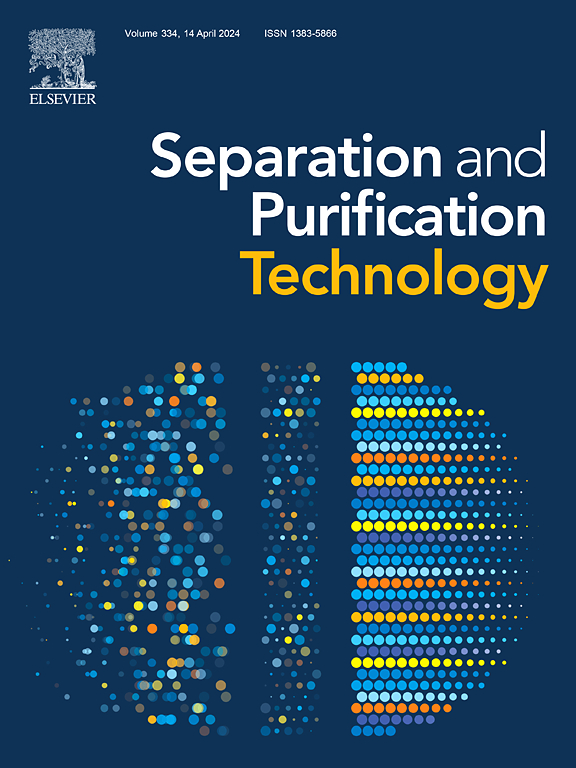Symmetric dual-cathode sandwich system for enhanced peroxymonosulfate electrochemical activation and stable water decontamination: performance and mechanism
IF 8.1
1区 工程技术
Q1 ENGINEERING, CHEMICAL
引用次数: 0
Abstract
The current peroxymonosulfate-electrochemical advanced oxidation process (PMS-EAOP) systems face the challenges of poor stability and efficiency, limiting the application in industry and practical scenarios. Herein, a dual-cathode sandwich (DCS) PMS-EAOP system was established for efficient degradation of aqueous emerging contaminants with long-term stability. A titanium-based antimony/iridium-doped tin oxide (Ti/AITO) anode was enclosed symmetrically by dual stainless-steel cathodes, achieving reliable water purification through a synergistic mechanism of reactive oxygen species generation and direct electron transfer (DET)-based non-radical pathways. Comprehensive investigations were conducted on the degradation performance of diverse pharmaceutical and personal care products and endocrine-disrupting chemical. Operational parameters were systematically optimized to maximize pollutant removal efficiency. Mechanistic insights were gained through degradation pathway analysis, toxicity assessment, and radical species identification. The removal of the model ranitidine contaminant with a pseudo-first-order rate constant of 0.198 min−1 was attributed to the synergistic action of •OH, SO4•− and 1O2, and the DET-based non-radical pathway. The DCS-PMS system demonstrated robust operational stability in complex water matrices, including natural and urban water bodies, and maintained exhilarating performance under long-term continuous operation for over 60 h. Notably, the system achieved a ∼67 % total organic carbon removal within 120 min when applied to high-concentration real antibiotic wastewater. This work offers insights for advancing the development of EAOPs with scalable design, simple assembly, and high durability in wastewater treatment.

对称双阴极夹层系统增强过氧单硫酸盐电化学活化和稳定水净化:性能和机理
目前的过氧单硫酸盐-电化学高级氧化工艺(PMS-EAOP)系统面临稳定性和效率差的挑战,限制了其在工业和实际应用中的应用。为此,建立了一种双阴极夹层(DCS) PMS-EAOP系统,该系统可以长期稳定地高效降解水中新兴污染物。钛基掺锑/铱氧化锡(Ti/AITO)阳极被双不锈钢阴极对称封闭,通过活性氧生成和基于直接电子转移(DET)的非自由基途径的协同机制实现可靠的水净化。对多种医药、个人护理用品及内分泌干扰物的降解性能进行了全面的研究。系统优化操作参数,最大限度地提高污染物去除效率。通过降解途径分析、毒性评估和自由基种类鉴定获得了机制见解。模拟雷尼替丁污染物的去除伪一阶速率常数为0.198 min - 1,这归因于•OH、SO4•−和1O2的协同作用以及基于det的非自由基途径。DCS-PMS系统在复杂的水基质(包括自然和城市水体)中表现出强大的运行稳定性,并在超过60 h的长期连续运行下保持令人振奋的性能。值得注意的是,当应用于高浓度真正的抗生素废水时,该系统在120 min内实现了 ~ 67 %的总有机碳去除率。这项工作为推进EAOPs的发展提供了见解,该EAOPs具有可扩展的设计,简单的组装和废水处理中的高耐用性。
本文章由计算机程序翻译,如有差异,请以英文原文为准。
求助全文
约1分钟内获得全文
求助全文
来源期刊

Separation and Purification Technology
工程技术-工程:化工
CiteScore
14.00
自引率
12.80%
发文量
2347
审稿时长
43 days
期刊介绍:
Separation and Purification Technology is a premier journal committed to sharing innovative methods for separation and purification in chemical and environmental engineering, encompassing both homogeneous solutions and heterogeneous mixtures. Our scope includes the separation and/or purification of liquids, vapors, and gases, as well as carbon capture and separation techniques. However, it's important to note that methods solely intended for analytical purposes are not within the scope of the journal. Additionally, disciplines such as soil science, polymer science, and metallurgy fall outside the purview of Separation and Purification Technology. Join us in advancing the field of separation and purification methods for sustainable solutions in chemical and environmental engineering.
 求助内容:
求助内容: 应助结果提醒方式:
应助结果提醒方式:


